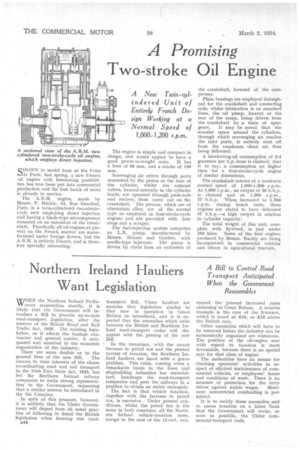A Promising Two-stroke Oil Engine
Page 58

If you've noticed an error in this article please click here to report it so we can fix it.
SIIOWN in model form at the Fairede Paris, last spring, a new French
oil engine with interesting possibilities has now been put into commercial production and the first batch of units is already in service.
The A.B.M. engine, made by Messrs. P. Buddy. 54, Rue Stendhal, Paris, is a twin-cylindered two-strokecycle unit employing direct injection and having a blade-type air-compressor mounted on an extension of the crankshaft. Practically all oil engines at present on the French market are manufactured under foreign licence, but the A.B.M. is entirely French, and is therefore specially interesting. The engine is simple and compact in design, and would appear to have a good power-to-weight ratio. It has a bore of 96 ram. and a stroke of 130 ram.
Scavenging air enters through ports unmasked by the piston at the base of the cylinder, whilst the exhaust valves, located centrally in the cylinder heads, are operated through push-rods and rockers, from cams cut on the crankshaft. The pistons, which are of aluminium alloy, are of the normal type as employed in four-stroke-cycle engines and are provided with four rings and a scraper.
The fuel-injection system comprises an L.B. pump, manufactured by Messrs. 13auzec and Gautier, with needle-type injectors. The pump is driven by chain from an extension of the crankshaft, forwatd of the compressor. Plain bearings are employed throughout for the crankshaft and connecting rods, whilst lubrication is on standard lines, the oil 'pump, located at the rear of the sump, being driven from the crankshaft by a train of spur gears. It may be noted that the annular space around the cylinders, through which scavenging air reaches the inlet ports, is entirely shut off from the crankcase, clean air thus being delivered.
A lubricating-oil consumption of 3-4 grammes Per h.p.-hour is claimed; that is to say, a consumption no higher than for a four-stroke-cycle engine of similar dimensions.
The crankshaft rotates at a moderate . normal speed of 1,000-1,200 r.p.m. At 1,000 r.p.m., an output of 20 b.b.p. is claimed and at 1,200 r.p.m., 27 b.h.p. When increased to 1,700 r.p.m. during bench tests, these engines are stated to have delivered 47 b.h.p.—a high output in relation to cylinder capacity.
The total weight of this unit, complete with flywheel, is just under 250 kilos. Some of the first engines produced by -Messrs. Buckly are being incorporated in commercial vehicles and others in agricultural tractors.




























































































